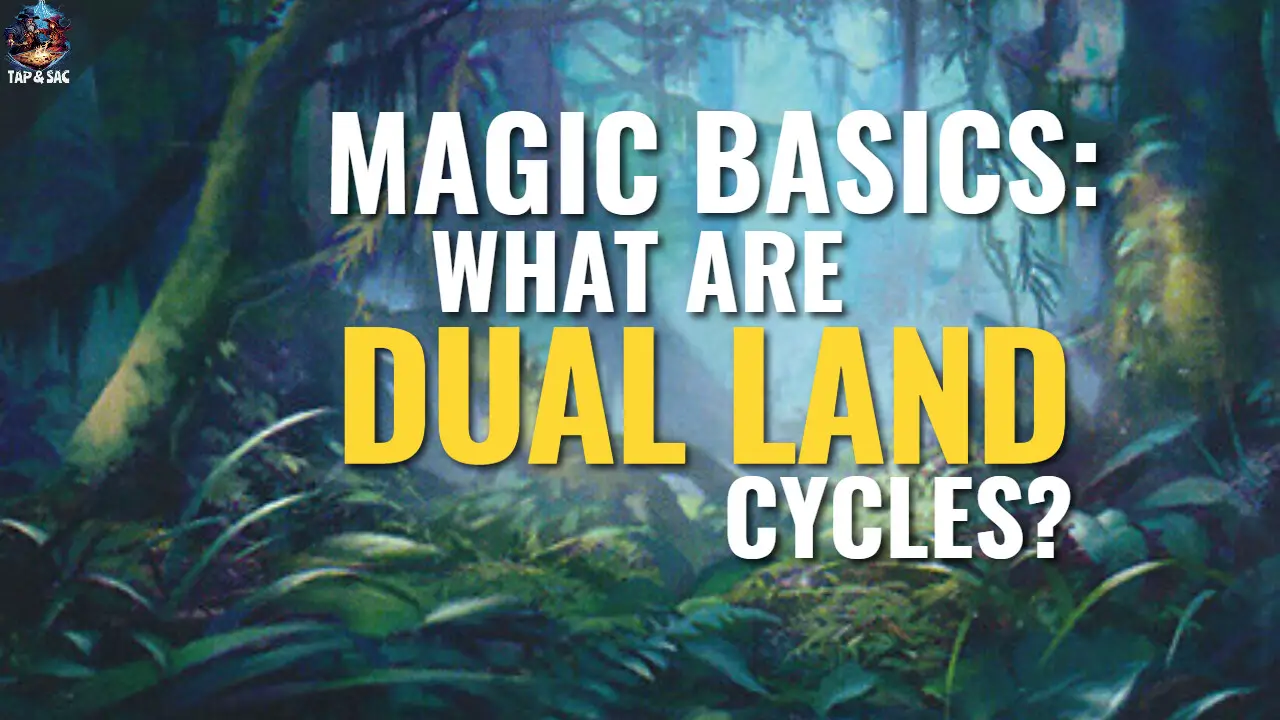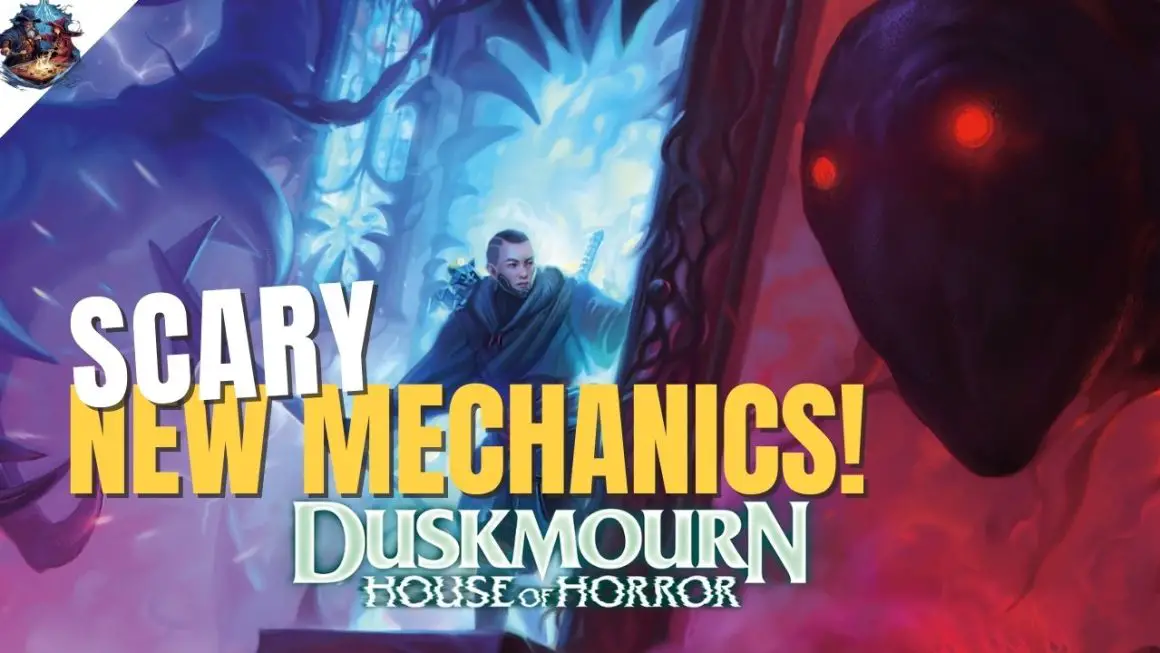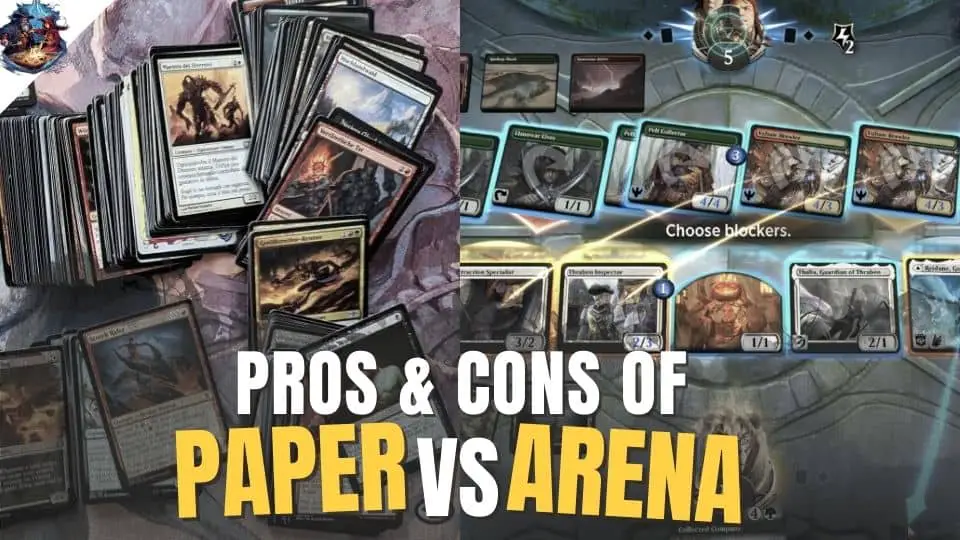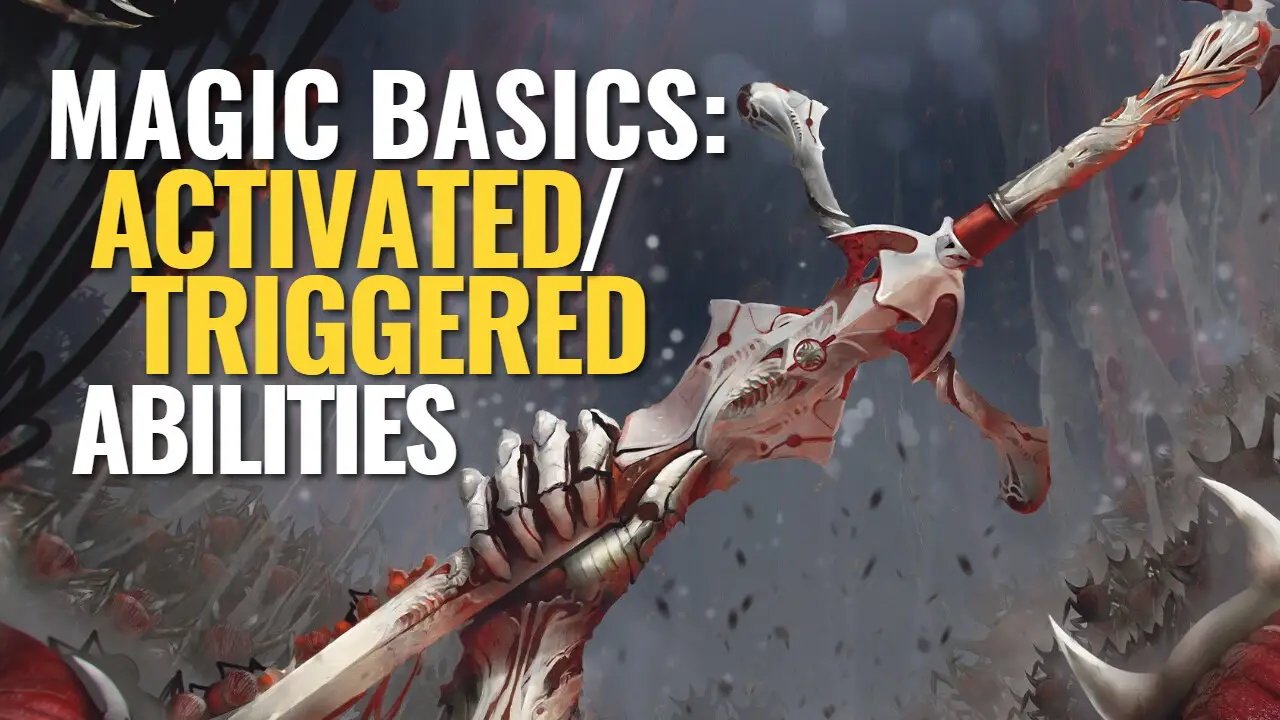Every MTG player begins by learning the concept of Lands and how they generate Mana. The 5 Basic Lands (Plains, Island, Swamp, Mountain and Forest) generate the 5 different colours of Mana.
Then there are the Non-basic Lands in MTG. They are considered Non-basic because they do more than what a basic land does. For instance, they often generate utility in the form of some kind of Activated Ability. The other common reason, and the focus of this lesson, is that they can generate two or more different coloured Mana.
The term “Dual Land” has become the widely-accepted lingo in MTG for any Land that gives you the choice of 2 different coloured Mana. In 30 years of Magic history, various renditions of a “Dual Land” have been introduced, and below you’ll find a comprehensive guide to the different cycles of Dual Lands and how they fit into the game.
Bounce Lands
“Bounce Lands” is a common nickname for a cycle of Dual Lands that first appeared in the original Ravnica block and were later reprinted in other sets.
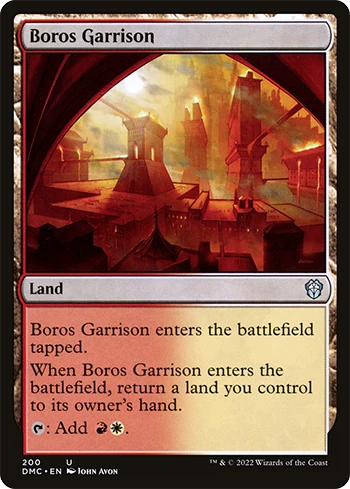
Bounce Lands have a unique ability that makes them distinct from other Dual Lands. Here’s how they work:
- Comes into Play Tapped: When you play a Bounce Land, it enters the battlefield tapped, meaning you can’t use it for mana on the turn it comes into play.
- Produce Two Mana: Bounce Lands tap for two mana of two different colours.
- Bounce Ability: The key feature of Bounce Lands is their “bounce” ability. When a Bounce Land enters the battlefield, you must return a land you control to your hand. This is a mandatory part of the land’s ability. This can slow down your mana development temporarily but provides the benefit of tapping for two mana once you replay the Bounce Land.
The bounce ability has both advantages and disadvantages. On the positive side, Bounce Lands help fix your mana by producing two different colours of mana, which can be especially useful in multicolour decks. They are also especially useful in decks that take advantage of the Landfall mechanic, since you can replay the same Land twice.
On the negative side, the bounce ability can slow down your mana development in the early game.
Check Lands
Check Lands were first introduced in the 2010 core set Magic 2011 (M11) and have been reprinted in later sets such as Dominaria (2018). Check Lands are popular for their ability to produce two different colors of mana and for their relatively easy activation condition.
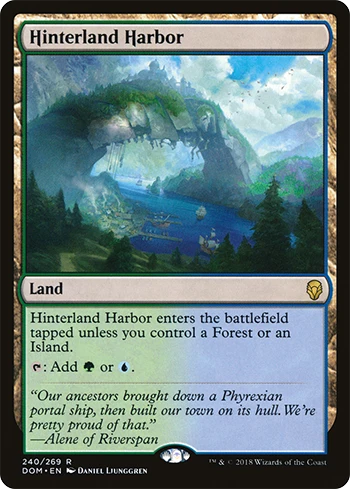
Here’s how Check Lands work:
- Easy Condition to Come into Play Untapped: Check Lands have the potential to enter the battlefield untapped, allowing you to use them immediately if you control a land with one of the two specified basic land types (e.g., Plains and Island).
Check Lands are well-regarded for their flexibility in multicolour decks because their condition to Enter the Battlefield untapped is relatively easy. Many other Non-basic Lands also count as Basic Land types, hence a player doesn’t necessarily need to have Basic Lands. As a Dual Land, Check Lands are commonly used in Standard and other constructed formats where they are legal, as they provide excellent mana-fixing options.
Crowd Lands
Crowd Lands were designed specially for Commander as it was first released in the Battlebond set that was aimed towards multiplayer play. They are sometimes known as Bond Lands (named after the set) but ultimately they have the “crowd” tag because of its unique Enter the Battlefield condition.

Here are the characteristics of Crowd Lands:
- Opponent-Centric Condition: Crowd Lands like Sea of Clouds have a condition that they will come in untapped if you have 2 or more opponents. In a multiplayer game, that is easily achievable unless the Land comes into play late in the game when you are only left with 1 opponent.
Because its restriction is easily bypassed in multiplayer, Crowd Lands have become very popular Dual Lands in the Commander format (perhaps second only to the original Dual Lands), but on the other hand they are essentially useless in a constructed, 1-v-1 format such as Legacy.
(The Original) Dual Lands
The original Dual Lands in MTG are a set of ten rare Lands that were first printed in the game’s early expansions, specifically the Alpha and Beta sets released in 1993. These lands are collectively known as the “original” Dual Lands. They are highly prized by players and collectors for their unique and powerful abilities.

Each of the original Dual Lands has two Basic Land types, allowing them to produce one of two different colours of mana without any restrictions. Here are the ten original dual lands:
- Tundra: Plains/Island
- Scrubland: Plains/Swamp
- Badlands: Swamp/Mountain
- Taiga: Mountain/Forest
- Plateau: Mountain/Plains
- Tropical Island: Island/Forest
- Underground Sea: Island/Swamp
- Bayou: Swamp/Forest
- Volcanic Island: Island/Mountain
- Savannah: Plains/Forest
These Dual Lands are considered some of the best lands ever printed in Magic because they provide mana fixing without drawbacks, unlike many other Dual Lands that have drawbacks such as coming into play tapped or causing life loss. Their only ‘downside’ is that they do not provide any other kind of utility, unlike the Scry Lands, for example. They had been reprinted in very early sets, but are no longer reprinted because they belonged to the Reserved List.
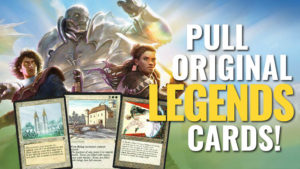
Fast Lands
Fast lands are a known for their ability to enter the battlefield untapped during the early stages of the game. These lands were first introduced in Scars of Mirrodin (2010) and have been reprinted in subsequent sets, the most recent in 2023’s Phyrexia: All Will be One.
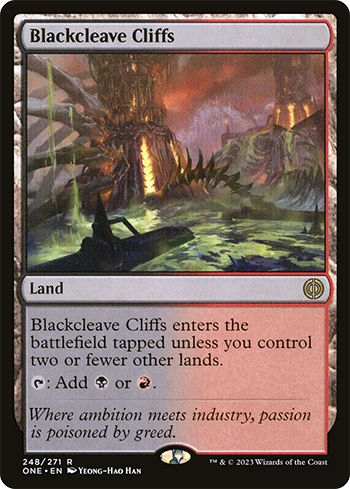
Here’s how Fast Lands work:
- Comes into Play Untapped Early: Fast lands are designed to enter the battlefield untapped during the early turns of the game. Specifically, they will enter untapped if it’s one of your first three turns. After that, they may enter tapped.
- No Drawbacks: Unlike many Dual Lands, fast lands do not come with drawbacks like returning another Land or causing life loss (see Shock Lands). They are a reliable source of mana fixing in the early game.
Fast lands are popular for their ability to provide consistent, untapped mana during the early game, which is crucial for casting spells on curve and maintaining tempo. They are often used in aggressive and midrange decks in formats like Modern and Pioneer, where efficient mana development in the early turns is vital.
These lands are not used as frequently in longer, control-oriented games, as they may enter tapped during later turns. Nevertheless, they are valuable additions to many deck archetypes, and players often include them to ensure a smooth mana base and minimize the risk of mana screw in the early game.
Fetch Lands
Fetch Lands have been a staple in the game for many years. While they don’t directly tap for Mana, these lands are known for their powerful mana-fixing ability and deck-thinning effect. Fetch Lands were first introduced in the Onslaught set and have since been reprinted in various sets.

Here’s how Fetch Lands stand out:
- Tapped Ability: Fetch lands can be tapped to Sacrifice themselves and search your library for 1 of 2 specific Basic Land types. Each Fetch Land specifies the type of land it can search for, such as a Plains, Island, Swamp, Mountain, or Forest.
- Deck-Thinning: Fetch lands are known for their deck-thinning effect. By sacrificing a fetch land and searching your library for a land, you effectively remove a Land card from your Library, slightly increasing the likelihood of drawing non-land cards in future draws.
- Mana Fixing: Fetch lands provide excellent mana-fixing capabilities. Not only can they search for a Basic Land card, they can also search for Nonbasic Lands that fit the criteria. A good example is a Shock Land like Steam Vents, then is able to Enter the Battlefield untapped and be able to add either blue or red Mana.
- Shuffle Effect: Fetch lands also trigger a shuffle effect. After you search your library and find the basic land, you shuffle your library. This can be strategically relevant in formats where you know the order of your library matters (e.g., if you’ve manipulated the top of your library with other cards).
Fetch Lands are highly sought after by competitive players due to their flexibility and deck-thinning benefits. They are often used in formats like Modern, Legacy, and Vintage, where a wide range of sets and cards are legal, allowing players to maximize their mana-fixing potential. Some famous examples of fetch lands include Scalding Tarn and Polluted Delta, among others.
Filter Lands
Filter lands were first introduced in the Lorwyn set and have been reprinted multiple times. Filter lands are notable for their ability to provide flexible Mana fixing, allowing players to convert one colour of Mana into another.

These are the characteristics of Filter Lands:
- Comes into Play Untapped: Filter lands typically enter the battlefield untapped, so you can use them for Mana immediately.
- Colourless Mana and Conversion Ability: Filter lands have an Activated Ability that allows you to tap them and add one colourless Mana to your mana pool. Additionally, they have an ability that lets you pay one coloured mana to filter that coloured mana into another colour of your choice. For example, the Cascade Bluffs Dual Land has the following abilities:
- Tap: Add 1 colourless Mana
- Blue or Red Mana, Tap: Add 2 Mana of any combination of red and blue.
Filter lands are known for their flexibility in multicolour decks because they can help smooth out your Mana base. If you have one colour of mana you don’t need, and need more of another colour, you can use a filter land to convert the excess mana into the needed colour.
Man Lands
Man Lands is a slang for a specific Land that has the ability to turn into a creature – this applies to both Dual Lands and other Lands that tap for just 1 coloured Mana. These lands can become Creatures temporarily, allowing you to attack with them or use their creature abilities, often till the end of that turn. Man Lands are valuable because they provide both Mana and a potential threat on the battlefield.

Man lands were first introduced in Worldwake and have appeared in various sets since then. Each man land typically corresponds to one of the five allied color pairs and produces Mana of those colours.
Here are the key characteristics of man lands:
- Comes into Play Untapped: Man lands typically enter the battlefield untapped, so you can use them for mana immediately.
- Activated Ability: Man lands have an Activated Ability that allows you to turn them into creatures. This ability usually requires tapping the land and spending mana.
- Summoning Sickness: When a man land becomes a Creature, it is still affected by summoning sickness, meaning it can’t attack or use abilities with the tap symbol unless it has been under your control since the beginning of your most recent turn.
- Return to Land: Man lands typically return to being regular lands during your untap step. This means they can provide mana again on your next turn.
Man lands are popular in various formats, including Modern, Legacy, and Commander, because they offer versatility by providing both mana fixing and the potential to apply pressure or block threats when needed. They are commonly used in control and midrange decks that want to have a flexible mana base while also having the option to present threats on the battlefield.
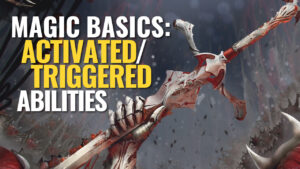
Pain Lands
These lands are called Pain Lands because they can generate mana of two different colours, but using them comes at a price — they can deal damage to you when tapped for coloured mana. Pain lands were first introduced in the Ice Age expansion set and have since been reprinted in many sets as recently as 2022 and 2023.
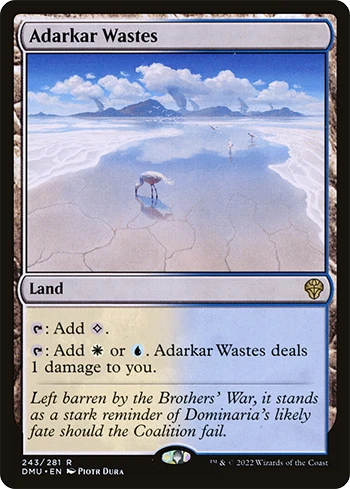
Here’s how Pain Lands work:
- Comes into Play Untapped: Pain lands typically enter the battlefield untapped, so you can use them for Mana immediately.
- Pay Life for Coloured Mana: To use a pain land for colored mana, you must tap it and choose one of the two colours it produces. However, using the pain land in this way comes at a cost — you must pay 1 life for each Mana generated. For example, Adarkar Wastes is a Pain Land that can tap for either white or blue mana, and each time you tap it for coloured mana, you take 1 damage.
Reveal Lands
Reveal Lands were introduced in Shadows over Innistrad. These lands are notable for their unique mechanic, which allows them to enter the battlefield untapped if you meet a specific condition: revealing a certain basic land type from your hand when they enter the battlefield.
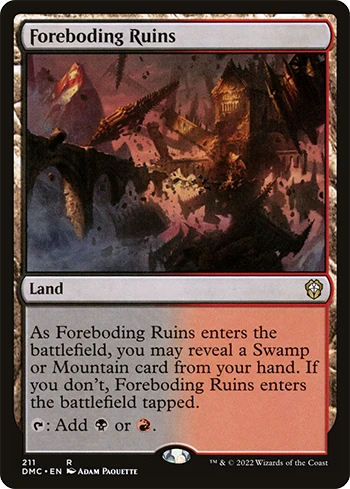
Here’s how Reveal Lands are different:
- Tapped or Untapped: Reveal lands have the potential to enter the battlefield either tapped or untapped, depending on whether you can (or want to) meet the condition of revealing a specific basic land type from your hand when they enter the battlefield.
- Conditional Untapped Entry: If you reveal a basic land card of the specified type from your hand as the reveal land enters the battlefield, it will enter untapped. This means you can use it for mana immediately.
- Flavorful Theme: The mechanic of revealing a basic land from your hand is tied to the flavor and theme of the Shadows over Innistrad block, where the setting features mysterious and supernatural occurrences.
Reveal Lands can be useful in multicolor decks because they offer the potential to provide untapped dual mana. However, they do require you to have the appropriate Basic Land card in your hand at the right time. As such, they require some deck-building consideration to ensure they can reliably enter untapped when needed.
Scry Lands
Scry Lands provide a unique Scrying ability in addition to producing mana. These lands were first introduced in the Theros block and have been reprinted in various sets.

Here are the unique characteristics of Scry Lands:
- Comes into Play Tapped: Scry Lands typically enter the battlefield tapped, meaning you can’t use them for mana on the turn they come into play.
- Scry Ability: The key feature of Scry Lands is their triggered ability, which allows you to Scry when they enter the battlefield. Scry is a mechanic that lets you look at a certain number of cards from the top of your library and then put cards on top of your Library or move them to the bottom in any order. For example, when Temple of Enlightenment enters the battlefield, you will Scry 1. (Look at the top card of your library. You may put that card on the bottom of your library.)
Scry lands are popular for their ability to help players manipulate their future draws. When you play a scry land, you get to look at the top card of your library and decide whether to keep it there or push it to the bottom, which can help you set up your next few draws or find the cards you need.
Shock Lands
Shock lands are highly versatile and are known for their ability to provide two different colours of Mana while also having the option to enter the battlefield untapped at the cost of 2 life. Shock Lands were first introduced in the Ravnica block and have been reprinted in various sets since then, the latest in Unfinity (2002).

Here’s what’s special about Shock Lands:
- Count as Basic Land Types: Shock lands have two basic land types, making them capable of producing two different colors of mana without any restrictions. As they count as a Basic Land type (e.g. Mountain), they can be searched from the Library by using a Fetch Land like Bloodstained Mire.
- Comes into Play Untapped with a Cost: Shock lands have the option to enter the battlefield untapped at the cost of 2 life, allowing you to use them for Mana immediately. This major difference from other dual lands (that don’t have the option of coming in untapped) makes Shock Lands one of the most playable and sought after in the game. For example, “Watery Grave” is a black/blue shock land. When it enters the battlefield, you can choose to have it enter tapped with no life loss or untapped by paying 2 life.
Shock lands have been used in various formats, including Modern, Legacy, and Commander. They are highly sought after by players because of their versatility and for being able to synergise very well with Fetch Lands (also a staple in many formats).
End Step
As comprehensive as this guide has been for the various Dual Land cycles in MTG history, this list is not exhaustive. There are Dual Lands that also gain 1 life as they Enter the Battlefield (tapped), and then there are also just standard Dual Lands with no extra abilities apart from the fact that they count as Snow Basic Lands (another topic to get into). However these Dual Land slangs above should give you a better understanding of Mana-fixing options in the game.

